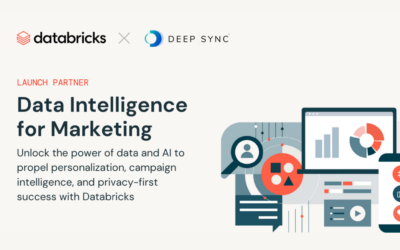Picture this: you’re an entrepreneur running a small pet care business. You’re proud of the unique products and services your business offers, and it’s clear that you’re filling a need within your community. However, your sales numbers have stagnated, and you just can’t seem to grow. What are you missing?
The answer could be within your customer data! While this may sound like obvious advice, many businesses miss critical opportunities hidden in their data. For example, 87% of marketers say that data is their organization’s most underutilized asset.
When you use your data to its full potential, you can take advantage of what you know about your customers to strengthen those relationships, use data-driven marketing strategies, and better understand your business’s strengths and weaknesses. In this guide, we’ll explore the top ways you can use customer data to support your growth.
Why is data important to your small business?
Data is an invaluable resource to your business. It allows you to make informed decisions, quickly adapt to trends and changing environments, and create tailored communications. These factors make it easier to create genuine relationships and build trust with your customers.
Strong relationships give your business a loyal support system that allows you to stay successful over time. Here are the basic types of data you might use to gain the insights needed to foster connections with customers:
- Zero-party data: Data customers share voluntarily, such as feedback via surveys or in-person interactions.
- First-party data: Information collected from customers’ interactions with your business’s owned properties, like your website or brick-and-mortar store.
- Second-party data: Another organization’s first-party data that is shared with yours through a partnership to help you understand and expand your audience.
- Third-party data: Data purchased from a provider, usually aggregated from a variety of sources to help you learn more about your customers and reach new audiences.
Keep in mind that the U.S. has stringent guidelines and regulations around customer data privacy, such as the Fair Information Practices Principles (FIPPs) and the California Consumer Privacy Act (CCPA). Get familiar with them to ensure you remain compliant.
How can you use customer data to your advantage?
As mentioned, there are many different sources and methods for acquiring customer data. Think about your current business processes and how you can glean insights from each touch point with customers.
Returning to our pet-care business example, perhaps you use specialized pet-scheduling software to manage grooming bookings, check-in/out processes, and service add-ons. From these interactions, you can learn how often customers need your services, note grooming preferences, and identify new needs through add-on purchases.
Here’s how you can use insights like these to enhance your business:
1. Clean and enrich your data.
The phrase “garbage in, garbage out” describes what will happen if you try to work with lackluster data. Your output will only ever be as good as your input, meaning that flawed and incomplete data will lead to equally flawed and incomplete insights.
To ensure you’re getting the full, up-to-date picture of your customers, follow data hygiene best practices like:
- Establishing data governance
- Creating standardized data entry practices
- Removing errors, outdated information, and duplications
- Backing up data
- Regularly auditing and updating your data
Your business can also benefit from enriching its data. This practice of supplementing your first-party data with information from trusted, third-party data sources provides additional information about your customers to enhance targeting and personalize your communications.
2. Enhance and personalize customer experiences.
Using your fresh, clean data, start looking for trends in customer preferences. Once identified, you can use these trends to create personalized customer experiences that boost engagement and retention.
Some ways to enhance customers’ experiences using data are to:
- Launch targeted marketing campaigns. Segment customers into groups based on similar characteristics, like demographics, purchasing habits, or how long they’ve been a customer. Leveraging marketing analytics, craft tailored marketing messages that will resonate most with that subgroup of customers.
- Make behavior-based recommendations. Within your marketing messages, add recommendations based on customers’ past behaviors. For example, if a client at your hair salon regularly visits to maintain their blonde color, you might recommend hair care products designed for blonde hair.
- Offer tailored customer support. Maintain centralized records of customer data, interactions, behaviors, and general notes. Then, leverage this information when providing customer support. This shows that you know who they are and how they’ve supported your business in the past, which can be especially helpful when managing conflicts.
Additionally, be sure to track broader trends that can help you make customer experiences better, such as identifying and preparing for busy times of the day. For example, dog daycares might be busiest in the morning from 7:00 to 9:30 when people are dropping off their pets before work. In this case, Gingr’s guide to kennel management recommends that these businesses use technology that allows customers to check in ahead of time, reducing check-in desk chaos.
3. Improve offerings based on customers’ preferences.
In addition to providing the experiences customers are looking for, your business should aim to give them the products and services they want or need most. This demonstrates that you have your finger on the pulse of what customers expect and are willing to adjust and expand your offerings accordingly. Additionally, understanding which products and services are most popular can help you make smarter purchasing and product development decisions.
For example, let’s say you run a massage business, and you want to optimize your offerings to give customers what they want. You analyze existing data and collect feedback from customers via surveys and informal, post-session questions. From there, your business can:
- Identify your most popular massages and run specials on them.
- Add new types of massage therapy, like Swedish massages, based on customer requests.
- Provide add-ons customers think would enhance the experience, like heated stones or bamboo.
- Offer tailored packages and services based on customer needs. For example, sports massages for athletes or stress relief packages for those who get massages to unwind.
- Enhance in-room experiences by adjusting scents, temperatures, music volume, and light levels to each customer’s preferences.
- Sell the products used during services. For example, if clients enjoy the smell of a certain essential oil or love how soft the towels and robes are, point them toward those items in your shop.
Each of these elements improves the massage business’s service delivery and helps them align more closely with what customers want. Not only does this strengthen customer relationships, but it helps your business stand out from its competitors.
4. Educate your staff.
Remember to keep your staff in the loop. Inform them of key customer insights that are relevant to their role and how they can adjust their approach to customer service to respond to customers’ preferences and requests. If you roll out new processes, products, or services, explain why you’re making those changes.
This additional context can help staff understand the reasons behind certain changes, making them more likely to adopt new processes and go above and beyond. Plus, you’ll make them feel like valued, integral players in your business, boosting satisfaction and retention. And as NXUnite explains, strong employee retention has a host of benefits for small businesses, including reduced costs, stronger employee skill sets, greater efficiency, and improved morale.
Businesses on an upward trajectory ground their efforts in data. For a small business, strengthening your customer relationships using data is one of the best ways to supercharge your efforts. For next steps, plan data-informed marketing strategies, brainstorm new products and services to address audience pain points, and personalize communications with your core customer segments.












0 Comments